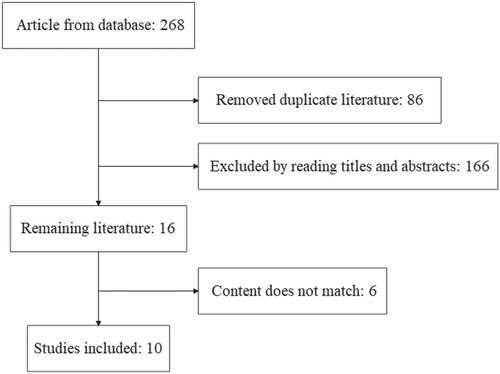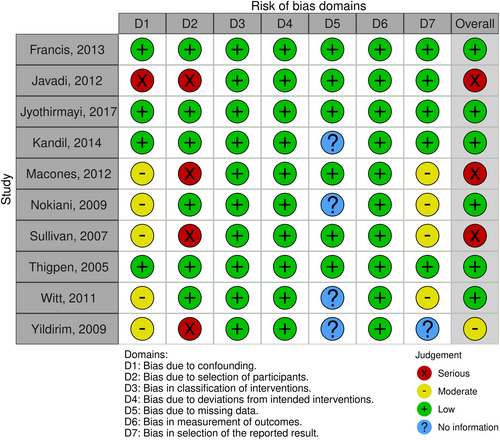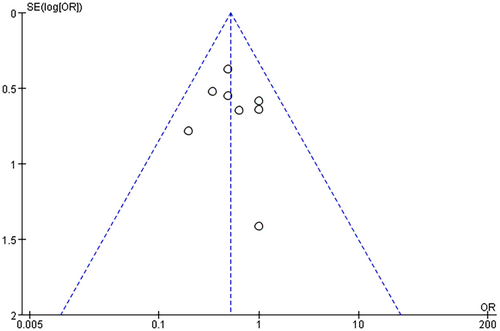RETRACTED: Effect of prophylactic use of cefazolin in caesarean section on postoperative infection: A meta-analysis
Abstract
Caesarean section rate is increasing and postoperative wound infection is a major health-threatening complication after caesarean section (CS). The aim of this study was to evaluate the efficacy of Cefazolin at different time for post-caesarean delivery. The aim of this study was to compare the use of Cefazolin at different times on infections after CS. The time of antibiotic use in CS can be divided into two groups: before skin incision (SI) and after cord clamping (CC). In this study, 268 relevant articles were found in the database, and finally, 10 articles were analysed. This study included a total of 5256 cases of caesarean section. The data on wound infections, endometritis, urinary tract infections and fever were analysed. Perform an analysis of the data using RevMan 5.3. The results showed that cefazolin before SI reduced wound infection compared to after CC (odds ratio [OR], 0.51; 95% CI: 0.37–0.69; p < 0.0001). Cefazolin prophylactically used before SI reduce endometritis after CS compared to after CC (OR, 0.52; 95% CI: 0.35–0.77; p = 0.001). There was no significant difference in urinary tract infections after CS between cefazolin prophylactically used before SI and after CC (OR, 0.80; 95% CI: 0.50–11.28; p = 0.35). There was no significant difference in fever after CS between the prophylactic use of cefazolin before SI and after CC (OR, 0.60; 95% CI: 0.26–11.43; p = 0.225). Cefazolin before SI reduces wound infection and endometritis after CS.
1 INTRODUCTION
Caesarean section (CS) is a critical solution for many acute and critical cases in obstetrics. CS has a larger effect on the post-delivery of pregnancy than in the case of spontaneous vaginal delivery.1 In order to achieve good perinatal period outcomes and reduce risks, The World Health Organization suggests that the CS rate should be less than 15%, whereas globally, CS rates are increasing.2, 3 Infection rate after CS is 5–20 fold compared to vaginal delivery.4 Therefore, measures need to be taken to reduce infections after CS.
Currently, prophylactic antibiotic use and aseptic measures before and during surgery are the main ways to reduce postoperative infections after CS.5, 6 Antibiotics used prophylactically can reduce the rate of CS infections by 60%–70%.7 The American College of Obstetricians and Gynecologists (ACOG) and other associations recommend the use of first-generation cephalosporins for the prevention of infections after CS.8 Antibiotic timing varies according to health care providers, and is mainly categorized as before SI and after CC. Due to concerns about transplacental transfer of antibiotics to the infant hiding symptoms of sepsis, drug resistance, most physicians choose to use antibiotics after cord clamping.
Although prophylactic use of cefazolin has been reported in the literatures to reduce wound infections after CS, the evidence is limited. Therefore, the purpose of meta-analysis is to summarize the optimal timing of cefazolin for the prevention of wound infection after CS.
2 METHODS
2.1 Search strategy
In November 2023, we looked up references from PubMed, Embase, and Cochrane Library electronic databases such as ‘caesarean section’ and ‘cefazolin OR cephazolin’ and ‘incision* OR infection OR dehiscence OR haematoma OR bleed* OR haematoma OR wound OR pain* OR VAS OR seroma’ (Table 1). The two authors evaluated the names and summaries of the retrieved studies separately, initially by manual exclusion of duplication and non-relevance studies, and finally by eliminating other kinds of research like reviews and case-reports. Where there was a disagreement between the two authors, it was settled by debate or by a third author's decision.
| No. | Query |
|---|---|
| #1 | Cesarean section [Title/Abstract] |
| #2 | cefazolin OR cephazolin [Title/Abstract] |
| #3 | incision* OR infection OR dehiscence OR haemorrhage OR bleed* OR haematoma OR wound OR pain* OR VAS OR seroma [Title/Abstract] |
| #4 | #1 AND #2 AND #3 |
2.2 Study inclusion criteria
Controlled or cohort studies than used cefazolin before incision and after cord clamping were included. Articles should be written in English and there is no restriction on the region or time of publication. We imported 268 retrieved articles into endnote X9 Literature Reader. We excluded 170 duplicate articles, 166 articles with title and abstract inconsistencies, 6 of them were excluded after reading the full text, and the last 10 articles met the requirements (Figure 1).

2.3 Data extraction
Both authors used RevMan 5.3 to extract the data; in case of disagreement, they were settled through a debate or a third-party examination. Choices were obtained, such as the name of the first author, the number of patients, the wound infection, the endometrium, the urine trail infection, and the fever. The results obtained for each group were tabulated.
2.4 Quality assessment
The Cochrane Collaboration's Risk Bias Assessment Tool, based on established meta-analyses, evaluated the trial quality of the trials that were part of the analysis. The assessment was carried out separately by 2 authors and involved randomized sequences, hidden assignment processes, a mechanism to blind study participants and staff, complete results, and sensitive selection and other potential biases. The risks were classified as Low, Uncertain or High. All disagreements among the evaluators were settled by consultation, and if no agreement could be found, third party evaluators were hired to mediate.
2.5 Data analysis
The statistical analysis was carried out with RevMan 5.3. The description of the statistical data was given in terms of the quantity and percent of the classification, and the average and the standard deviation of the numerical variables. Comparison of the proportions among the individual groups was performed with a chi-square test. The alpha significance of p < 0.05. I2 statistics have been used to estimate the heterogeneity of the trial. I2 >50% has been defined as substantial heterogeneity. When I2 is <50%, a fixed-effect model is applied; if not, a stochastic effect model is used. In order to examine whether there was a bias in publishing, we evaluated the size of the funnel plot. The symmetric distribution of the data points surrounding the funnel graph showed a reduced tendency for the results to be influenced by publication bias. By way of example, Egger's Linear Regression Test is a quantitative approach to detect any publication bias.
3 RESULTS
3.1 Study characteristics
A total of 268 relevant data were identified from the data base, and 10 of them were eliminated. This study involved 5256 CS, 2693 of which cefazolin was used before SI, 2564 after CC. Background data on the use of cefazolin for caesarean sections are presented in Table 2. A qualitative assessment of the included literature is presented in Figures 2 and 3.
| Study | Year | Country | Before SI | Age | After CC | Age |
|---|---|---|---|---|---|---|
| Francis | 2013 | American | 410 | 29 ± 6.67 | 391 | 29 ± 5.19 |
| Javadi | 2012 | Iranian | 375 | 26.19 ± 5.31 | 375 | 26.75 ± 5.62 |
| Jyothirmayi | 2017 | India | 553 | - | 543 | - |
| Kandil | 2014 | Egypt | 50 | 27.1 ± 2.4 | 50 | 25.7 ± 2.9 |
| Macones | 2012 | American | 217 | 28.9 | 217 | 28.3 |
| Nokiani | 2009 | Iranian | 196 | 27.3 ± 6.03 | 91 | 26.3 ± 6.07 |
| Sullivan | 2007 | American | 175 | 28.3 ± 6.1 | 182 | 28.3 ± 6.0 |
| Thigpe | 2005 | American | 153 | 23.5 ± 5.7 | 149 | 24.3 ± 5.9 |
| Witt | 2011 | Austrian | 370 | 31.3 ± 6.3 | 371 | 32.2 ± 5.8 |
| Yildirim | 2009 | Turkey | 194 | 28.25 ± 4.87 | 195 | 27.53 ± 5.02 |
- Abbreviations: CC, cord clamping; SI, skin incision.


3.2 Wound infection
All 10 articles9-18 provided the data in a meta-analysis of wound infections after CS. The results showed that the prophylaxis of cefazolin reduced wound infection after CS before SI compared with after CC (odds ratio [OR], 0.51; 95% CI: 0.37–0.69; p < 0.0001) (Figure 4).

3.3 Endometritis
Eight articles9-11, 13, 15-18 provided the data in a meta-analysis of endometritis after CS. The prophylaxis of cefazolin reduced endometritis after CS before SI compared with after CC (OR, 0.52; 95% CI: 0.35–0.77; p = 0.001) (Figure 5).

3.4 Urinary tract infection
Only 4 articles9, 11-13 provided the data in a meta-analysis of urinary tract infections after CS. There was no significant difference in urinary tract infections after CS between the prophylaxis of cefazolin before SI and after CC (OR, 0.80; 95% CI: 0.50–11.28; p = 0.35) (Figure 6).

3.5 Fever
Only 3 articles11, 13, 14 provided the data in a meta-analysis of fever after CS. There was no significant difference in fever after CS between t prophylaxis of cefazolin before SI and after CC (OR, 0.60; 95% CI: 0.26–11.43; p = 0.225) (Figure 7).

3.6 Publication bias
Bias analysis of published articles on the prophylaxis of cefazolin before SI and after CC for postoperative wound infections (Figure 8).

4 DISCUSSION
CS is an efficient way to deal with both acute and severe obstetric complications. The number of CS is increasing every year, with nearly 30 million performed annually worldwide.19 In this meta-analysis, which included 10 studies that were both relatively new and comprehensive, we compared the effect of the prophylaxis of cefazolin before SI and after CC on infection after CS. Our study provides a reference point for the preventive use of antibiotics in CS.
In 2020, Li20 published a meta-analysis showed that giving cefazolin before incision reduces surgical site infections after CS. Sun21 published a meta-analysis in 2013 showed that the prophylactic use of cefazolin reduced endometritis after CS. This study is different from these two meta-analyses. Firstly, we included more studies with 10 cases and 5256 CS. Secondly, we analysed wound infections, endometritis, urinary tract infections, and fever after caesarean delivery completely as well. In this meta-analysis, we found that the cefazolin reduced wound infection and endometritis after CS. Meanwhile, our study showed that there was no significant difference in the risk of urinary tract infection and fever after CS when cefazolin was used before SI and after CC. However, there are fewer studies and numbers of people with urinary tract infections and fever, requiring further follow-up studies to confirm.
The study has limitations. (1) The few studies included in this study were retrospective observations, with autonomous selectivity, which may have influenced our results. (2) The low diversity of the studies and the low number of urinary tract infections and fever seriously affect the credibility of the findings. (3) We did not analyse the dose of cefazolin, and it is possible that different doses of cefazolin may influence the outcome of the indicators after CS. (4) Studies were included from different countries, and geographic differences may have affected the results of the analysis.
5 CONCLUSION
The use of cefazolin before incision reduced wound infection and endometritis after caesarean section as (CS), and there was no significant difference in the risk of urinary tract infection and fever after CS when cefazolin was used before SI and after CC. However, further follow-up studies are needed to confirm this due to limited evidence.
ACKNOWLEDGEMENTS
We thank Prof. Jiqun Xu and Haicui Wu for their review of this study and suggestions for revisions.
CONFLICT OF INTEREST STATEMENT
The authors declare no conflict of interest.
Open Research
DATA AVAILABILITY STATEMENT
Data available on request from the authors.




